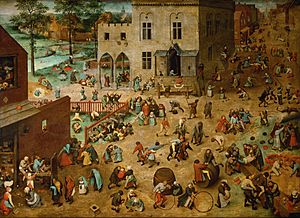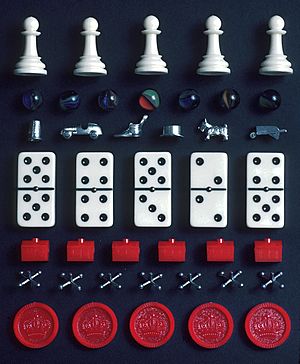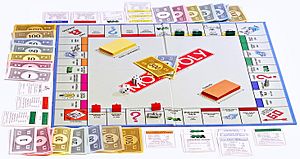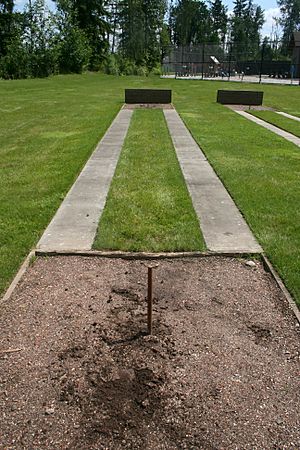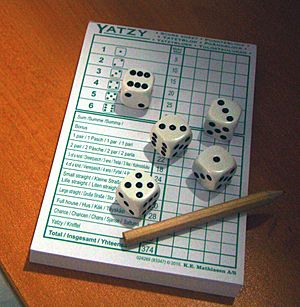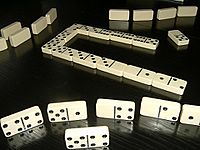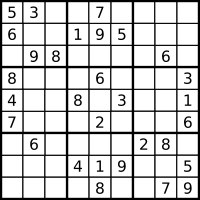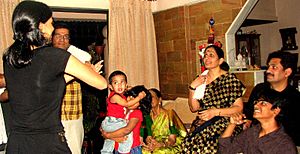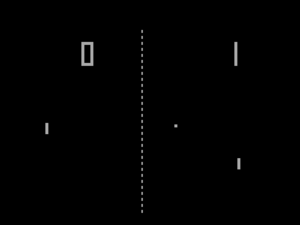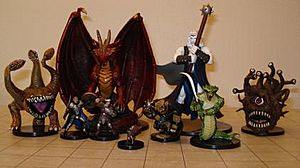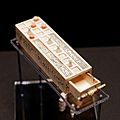Game facts for kids
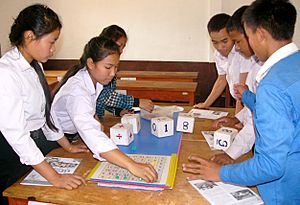

A game is an activity people do for fun. It's usually different from work. Many sports are games, and some people play them professionally. When games are played professionally, they can be a type of entertainment and people can earn money from them.
Games can use many different kinds of equipment. For example, in video games, players use controllers or keyboards to control what happens on a screen, like a television or computer. In card games, players use playing cards. Some games, like those played with a Kinect, use your body. Most games need some equipment, but not all. Many street games that children play need no equipment at all.
In board games, players move pieces on a flat surface called a board. The goal of the game changes. In race games like ludo, the goal is to reach the end first. In go the goal is to surround more space. In soccer it is to score more goals. Some games have complex rules, while others have very simple ones.
What Makes a Game?
Games are activities where players try to reach a goal by following certain rules. They often involve some kind of challenge or competition.
Here are some ways to think about what a game is:
- A game is a system where players face a challenge, follow rules, and get a clear result.
- It's a type of art where players make choices to use resources (like game pieces) to achieve a goal.
- A game is an activity between two or more players who want to reach their goals within certain limits.
- It's a form of play with specific goals and a clear structure.
How Games Work
Games are often described by "what the player does." This is called gameplay. The main parts of gameplay are the tools and rules that set up the game.
Game Tools
Games are often grouped by the things you need to play them. These can include miniatures, a ball, cards, a board and pieces, or a computer. Balls have been popular game tools for a long time, leading to many popular ball games like rugby, basketball, football, cricket, tennis, and volleyball.
Many game tools are like tokens. They stand for other things. A token might be a pawn on a board, play money, or even a point you score.
Game Rules
Rules usually decide how time works in a game, what players can and cannot do, and what each player's goals are.
For example, rules might say when you can use your resources or move your pieces. A winning rule could be having the most tokens at the end of the game, like in Monopoly.
Skill, Strategy, and Chance
The tools and rules of a game determine if it needs skill, strategy, luck, or a mix of these. Games are often sorted this way.
- Games of skill need physical ability, like wrestling, tug of war, hopscotch, or target shooting. They can also need mental skill, like checkers and chess.
- Strategy game|Games of strategy include checkers, chess, go, and tic-tac-toe. These often need special equipment.
- Games of chance include blackjack, mah-jongg, and roulette. They also include games like snakes and ladders and rock, paper, scissors. Most need things like cards or dice.
However, most games have a mix of these elements. For example, American football and baseball use both physical skill and strategy. Games like tiddlywinks, poker, and Monopoly mix strategy and chance. Many card and board games combine all three.
Single-Player Games
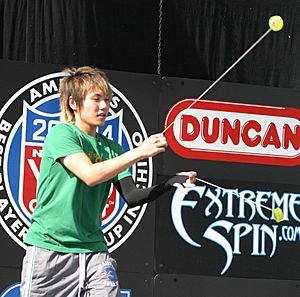
Most games need more than one player. But single-player games are special because the player faces challenges alone. In a one-player game, you might play against a computer, against your own skills, against time, or against chance. Playing with a yo-yo or hitting a tennis ball against a wall isn't usually called a game because there's no opponent.
Many games called "single-player" are actually puzzles or fun activities.
Types of Games
Games come in many forms, from competitive sports to board games and video games.
Sports
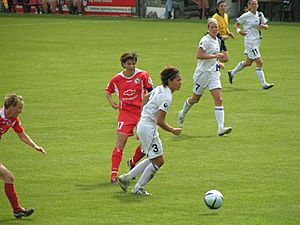
Many sports need special equipment and dedicated playing fields. This means a whole community might get involved, not just the players. A city or town might provide places for sports leagues.
Popular sports often have spectators who enjoy watching the games. People often support a local sports team, even if the team or its players are new to the area. They might also have strong rivalries with other teams. Being a "fan" of something first started with sports fans.
In sports like baseball, decisions like whether a pitch is a "ball" or a "strike" are made by an umpire. Their decision is final for that game.
Some competitive sports, like racing and gymnastics, are not always called "games" because competitors don't directly interact with each other. They just challenge each other indirectly.
Lawn Games
Lawn games are outdoor games played on a lawn (a mowed grass area) or on dirt. This area is usually smaller than a sports field. Many games traditionally played on a large field are also sold as "lawn games" for playing in a home yard. Common lawn games include horseshoes, croquet, and bocce.
Tabletop Games
Tabletop games are played in a small area, usually on a table. They don't need much physical effort, just moving game pieces.
Dexterity and Coordination Games
Games like jacks, paper football, and Jenga need simple equipment and can be played on any flat surface. Other games, like pinball, billiards, air hockey, and foosball, need special tables or machines.
Even though home video games became popular, games like air hockey, billiards, pinball, and foosball are still common in game rooms.
Board Games

Board games use a board as their main tool. Players track their status, resources, and progress using physical tokens on the board. Many also use dice or cards.
Some board games, like chess and Go, are all about strategy. Children's board games, like Candy Land and Chutes and Ladders, often rely more on luck.
Most other board games mix strategy and luck. For example, in backgammon, players decide the best move based on a dice roll. Trivia games have a lot of randomness based on the questions you get. German-style board games are known for having less luck involved than many other board games.
Board game types include race games, abstract strategy games, word games, and wargames.
Card Games
Card games use a deck of cards as their main tool. This can be a standard 52-card deck (used for bridge, poker, Rummy, etc.), or a special deck for a specific game (like Set or 1000 Blank White Cards). Uno and Rook were first played with standard decks but now have their own custom decks. Some collectible card games, like Magic: The Gathering, are played with a small set of cards that players collect.
Dice Games
Dice games use several dice as their main part. Popular dice games include Yahtzee, Farkle, and Liar's dice/Perudo.
Domino and Tile Games
Domino games are similar to card games, but they use a set of tiles called dominoes. Each domino usually has two ends with a certain number of dots, and each combination of dots is unique in the set. Muggins, Mexican Train, and Chicken Foot are popular domino games.
Other tile games exist too. Triominoes are triangular tiles with three values. Mah-Jongg is another game that uses a set of tiles with card-like values and pictures.
Pencil and Paper Games
Pencil and paper games need little or no special equipment, just writing materials. Some of these games have been turned into board games, like Scrabble (based on crossword puzzles) and tic-tac-toe. These games vary widely, from drawing games like Pictionary to word games like Boggle and logic puzzles like Sudoku.
Guessing Games
In a guessing game, one player knows a piece of information, and the goal is for others to guess it without being told directly. Charades is a very well-known guessing game, and Guess Who is popular with children.
Video Games
Video games are games controlled by a computer or microprocessor. Computers can create virtual worlds for many different types of games. Some video games copy real-life game objects like cards or dice. Others create fantasy worlds, each with its own rules and goals.
A video game uses one or more input devices. These are often buttons and a joystick (for arcade games), a keyboard, mouse or trackball (for computer games), or a controller (for console games).
There are many types of video games. The first commercial video game, Pong, was a simple game like table tennis.
Online Games
Modern online games are played using an Internet connection. Some need special programs to play, while others can be played right in a web browser. Some simpler browser games are popular with people who don't usually play many video games.
Role-Playing Games
Role-playing games, often called RPGs, are games where players pretend to be characters in a made-up world. Pen-and-paper role-playing games include Dungeons & Dragons and GURPS.
There are also many computer or internet role-playing games.
Related pages
Images for kids
-
Ancient Egyptian ivory game board from the exhibition of Tutankhamun's treasure in Paris (2019).
-
Ancient Egyptian gaming board for Amenhotep III with a sliding drawer, from 1390 to 1353 BC. It is made of glazed faience and is in the Brooklyn Museum.
-
The oldest full deck of playing cards known, the Flemish Hunting Deck, from around 1475–1480. It is made of paper with pen, ink, paint, glazes, silver, and gold, and is in the Metropolitan Museum of Art.
-
The Card Players, an 1895 painting by Paul Cézanne showing a card game, found in the Courtauld Institute of Art in London.
-
The Card Players by Lucas van Leyden (1520) showing a multiplayer card game.
See also
 In Spanish: Juego para niños
In Spanish: Juego para niños


